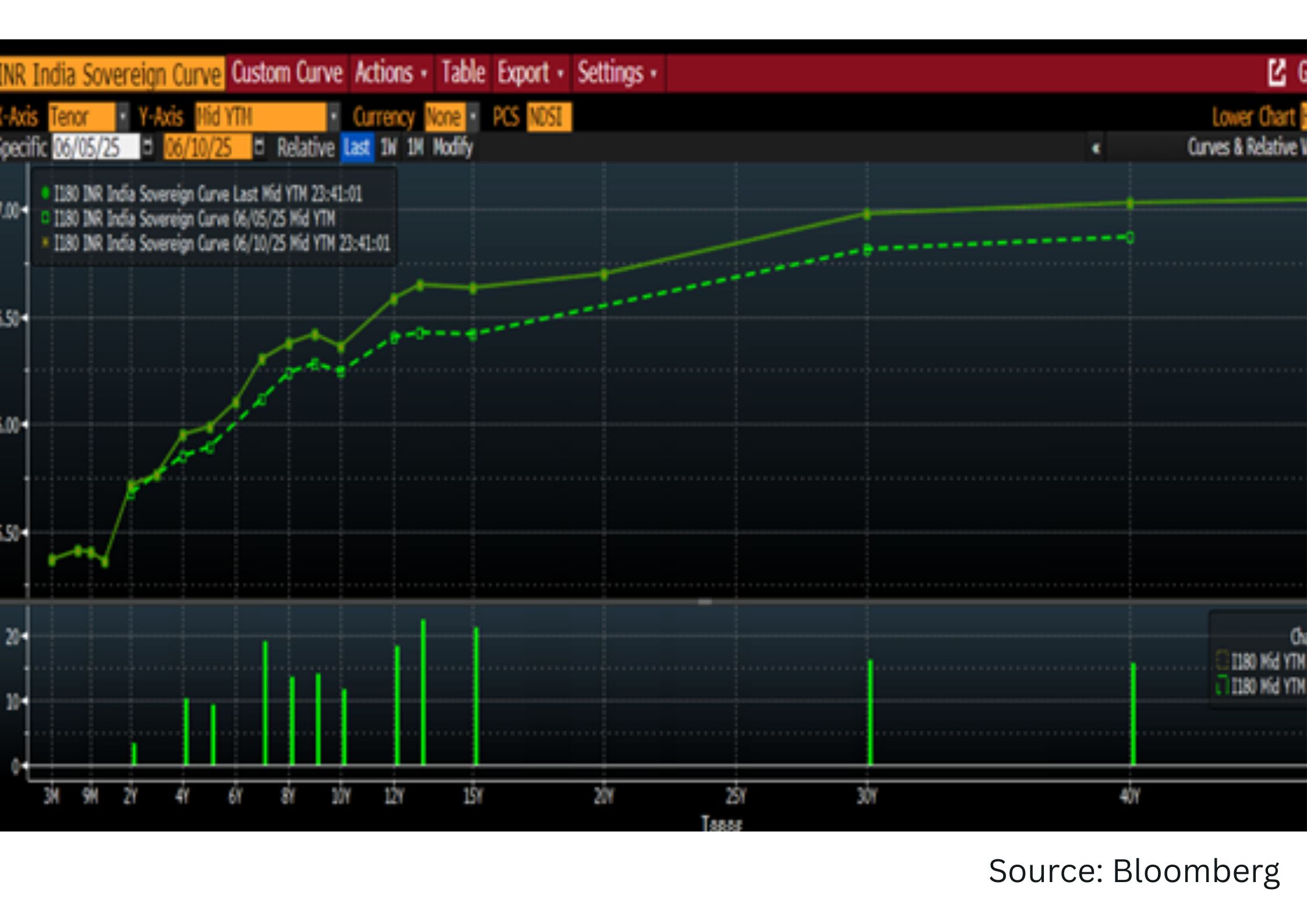.png)
Yield Scribe is a bond trader with a macro lens and a habit of writing between trades. He follows cycles, rates, and the long arc of monetary intent.
June 11, 2025 at 5:20 AM IST
When the Monetary Policy Committee announced a bazooka of monetary easing on June 6, the bond market lurched from euphoria to anxiety, and ultimately to confusion. The initial reaction was one of relief and optimism, but doubts quickly surfaced, particularly after the Governor’s post-policy press conference.
The market was left wondering whether the easing was substantive or already exhausted. The Reserve Bank of India’s communication, more than the action itself, appeared to rattle sentiment and obscure the path forward.
A 50-basis point policy rate cut, a change in stance only two months after the previous change, coupled with a future one percentage point reduction in the Cash Reserve Ratio, suggested urgency. Yet, judging by movements in bond yields between June 5 and June 10, the policy was interpreted less as a stimulus and more as a missed opportunity, or worse, a signal that easing options had already run their course.
Government bond yields across maturities climbed. The 10-year yield rose from 6.25% to 6.36%. The 15-year and 40-year yields moved up by 21 and 16 basis points, respectively. These are not typical outcomes of a rate cut. If anything, the yield changes resembled those following a stealth rate hike. The longer end of the yield curve, where term premiums tend to reflect investor confidence in the policy trajectory, showed distinct signs of stress.

Expectations going into the policy were more modest. The bond market had anticipated a 25-basis point rate cut, a continued accommodative stance, and a 30 to 40 basis point reduction in the inflation forecast for 2025–26.
Another rate cut in August was widely expected, taking the policy repo rate to 5.50% with further cuts possible in the second half of 2025-26. There was also an assumption that open market operations would resume in the second half of the financial year, supported by festive season currency requirements and the RBI’s maturing forward dollar rupee positions. Bond purchases worth ₹2 trillion to ₹2.5 trillion were considered plausible.
Instead, the central bank delivered a jumbo 50-basis point cut accompanied by an abrupt shift to a neutral stance. That pivot effectively signalled the end of the easing cycle. The post-policy commentary reinforced the perception that the rate-cutting space had been exhausted. What unsettled the market further was the ambiguity around liquidity operations. When the first question in the press conference raised the possibility of variable rate reverse repos making a return, the Governor declined to provide a clear denial.
Bond investors were not focused on the repo rate alone. Liquidity conditions, especially in an environment of surplus system liquidity, held equal importance. The lack of clarity from the central bank on this front added weight to fears that liquidity might be absorbed prematurely. Such a move would run counter to the intended transmission of the rate cut.
The Governor had previously clarified, in the April policy briefing, that the stance referred to the direction of rates, not liquidity. That distinction was absent this time. There was also no assurance that the objective was to ensure full pass-through of the rate cut rather than dilute its effects through liquidity absorption. The silence created more uncertainty than reassurance.
The result was a pronounced steepening of the yield curve. The term premium widened significantly, with the spread between the 10-year and 40-year government bonds jumping to 67 basis points, compared to an average of 30 basis points during the previous financial year. Nearly half of the Indian government’s gross borrowing in the April–June period is concentrated in tenures of 15 years and above. Those segments have faced the brunt of the post-policy sell-off, as institutional investors became wary of duration exposure in the absence of further policy support.
The evidence was visible in the change in the yield curve between June 5 and June 10. Despite a substantial rate cut and an upcoming CRR reduction, yields moved up across the curve. This was a direct contradiction of the policy’s stated intent to ease financial conditions.
Reverse Repo Fears
The impact was not limited to the sovereign bond market. Corporate bond yields also rose, especially in the 5–10-year segment. Yields on AAA-rated public sector undertaking bonds increased from 6.63% to 6.72% for the 5-year maturity and from 6.85% to 6.97% for the 10-year.
Concerns about a return to variable rate reverse repos have contributed to selling pressure in these segments as well. Investors are increasingly pricing in the risk that surplus liquidity may be temporarily mopped up, complicating credit flows and raising borrowing costs in the corporate sector.
The 50-basis point cut has therefore failed to provide the desired stimulus. Instead of softening borrowing costs, it has hardened them. The transmission mechanism, already weakened, appears to have stalled further. The real economy, which needed a sustained easing cycle to improve credit flows and investment sentiment, is now faced with a steeper yield curve and tighter conditions at the long end.
To repair the damage, clarity is essential.
A formal liquidity framework has been in the works for months and needs to be released without further delay. Bond investors require transparency and consistency in how the RBI intends to manage surplus liquidity, short-term shocks, and long-term expectations. Without a rules-based operational blueprint, policy actions risk being misread or mispriced.
In the near term, the central bank must explicitly clarify that variable rate reverse repos are not compatible with the current liquidity context. The middle of June brings natural liquidity compression due to advance tax outflows on June 15 and Goods and Services Tax payments on June 21. The Indian government’s ₹500 billion bond buyback programme was already announced to ease these seasonal pressures. Introducing liquidity-draining instruments now would be a misstep that undermines the very easing the policy was meant to deliver.
The borrowing calendar also merits reconsideration.
Demand for long-duration bonds has been tepid. Key public sector insurers have stayed away from recent auctions of 15-year and longer maturities. The 15-year bond now yields 25 basis points more than the 10-year, and the 40-year carries a 67-basis point premium. This steep curve signals a market preference for shorter tenures. A rebalancing of issuance towards the 3–7-year segment could help improve demand dynamics and flatten the curve, allowing for better monetary transmission.
The Governor’s track record of decisive liquidity management is well established. In past episodes, open market operations, buy-sell swaps, and variable rate tools were deployed with tactical precision. That credibility, however, now hinges on communication.
The intent behind the 50-basis point cut may have been well-founded, low inflation, moderate geopolitical tensions, emerging tariff concerns, and a need to support growth. But policy effectiveness is ultimately judged not by intent, but by market response.
This time, the response has been one of confusion and resistance. Yields have risen. Confidence has slipped. And the credibility of the transmission mechanism has come under strain.
If the central bank intends to regain market confidence, it must address the mixed signals delivered on June 6. Clear articulation of its liquidity stance, a more responsive borrowing strategy, and timely operational clarity will be essential. Without these, policy tools risk being blunted. Borrowing costs may remain elevated, and what began as a bold rate cut could be remembered instead for its squandered potential.




